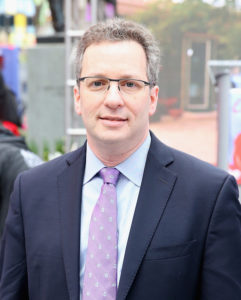Starting in July, President Lincoln’s Cottage is displaying a July 11, 1776 print of the Declaration of Independence. The piece is on loan from Seth Kaller Inc., and for this month’s Team Lincoln spotlight, we thought it fitting to get to know more about the namesake behind the collection company, Seth Kaller.
Tell us a bit more about the work you do with collections.
I buy and sell historic documents and artifacts, and build collections for philanthropic individuals and for institutions. But just because I’ve sold something doesn’t mean that I’m done with it. My clients almost always allow me to share their documents with the public in appropriate exhibits.
How’d you get into that line of work?
Just as I was about to graduate from college (University of Pennsylvania), I realized I didn’t want to get back to my family’s rare stamp and coin business. I decided to see if my background in other collectibles would work in the historic document field. I figured I’d do that for a year or two and then go to law school. But my first meeting with a prospective client went unexpectedly well, and Lewis Lehrman allowed me to start collecting for him. Within a year, Lew had me start collecting for Richard Gilder as well, and convinced me to stay with it. I’ve since acquired roughly 60,000 documents for the Gilder Lehrman Collection, on deposit at the New-York Historical Society. After seven years, the collection reached a critical mass, and I was able to take on additional clients.
What’s the biggest challenge?
Time management. Then there’s the problem of valuing priceless items. Value is a good word; by that I don’t mean slapping a price on it. What do we need to know to understand it? What does it tell us about the author, the event, the timing? If it changed the world, how? Then, there’s the challenge of bringing new collectors into a field that most people don’t even realize exists.
What’s the most fun component?
Bringing disparate elements together. And making discoveries – like finding that this Declaration newspaper [on display at the Cottage] came before New York’s official broadside made by the same printer. Sharing the history is really fun. I was showing my Alexander Hamilton Collection in Chicago. A group of young ladies who were on their lunch break came by to see it. When they saw Alexander’s love letter to Eliza, which happens to use a few words Lin Manuel Miranda also used in Hamilton, the girls started singing the song.
How and why did you first get involved with President Lincoln’s Cottage?
I’ve been privileged to have bought and sold many great Lincoln documents, and of course knew that Lincoln drafted the Emancipation Proclamation at the Cottage. I had arranged a couple loans previously, but I think the first time I actually visited was to set up the loan of an Emancipation Proclamation I helped David Rubenstein acquire.
Tell us more about the Declaration of Independence you’re lending to the museum. Where did it come from? What’s its connection to Lincoln?
When you say “Declaration of Independence,” most people picture the signed document. Yes, the “National Treasure” document is unique, but my client’s document preceded it. The “engrossed” copy was penned and signed in August, for posterity. More important at the time were original broadsides and newspapers that were used to spread the news of independence. This is a very rare newspaper printing, from July 11, 1776. News of the declaration had just arrived in New York two days earlier, by express, to George Washington and his army. The patriot printer John Holt decided to publish it on its own page, for patrons to separate from the paper and display. When nearly 30,000 British troops arrived in NY, I suspect most of them came down. Anyway, this is the only copy known in private hands, with four in museum and library collections. The other news is also amazing — like the report of the statue of King George being pulled down, taken to Connecticut, and melted into bullets. Soon, someone commented on the fact that British troops would be facing projectiles of “melted majesty.” I invite your readers to check out our full description and pictures at https://www.sethkaller.com/item/832.
What’s your favorite thing about Lincoln?
Of course “We hold these truths to be self-evident, that all men are created equal…” was written by Jefferson, who still deserves to be celebrated for saying it. But he and so many others had a huge blind spot. The words “all” and “men” must be more complicated than they seem. In any case, Lincoln’s true genius was in knowing exactly how far he could move the country at any particular moment. With our evolved understanding, we can criticize Lincoln for acting slowly or incompletely on slavery, and on human rights, and we won’t even get started on women’s rights. But in countless situations, with absolutely no margin for error, he was able to thread a needle that was so small other people couldn’t even see it. Jefferson based his rights on nature and “nature’s God”. Lincoln showed a more nuanced understanding of the Creator’s politics when he said that “I hope to have God on my side, but I must have Kentucky.” He kept Kentucky, and issued the Emancipation Proclamation, and ushered in the 13th Amendment. Without that, what would the Declaration mean today? Lincoln set us back on the path envisioned for America by the Declaration.
In your opinion, why should someone visit President Lincoln’s Cottage?
There’s something special that happens when genuine history can be seen in a place where history happened.
The July 11, 1776 Declaration of Independence will be on display in the OriginALs exhibit until January 4, 2019. Exhibits are found in the Robert H. Smith Visitor Education Center, open daily, 9:30am-4:30pm.

